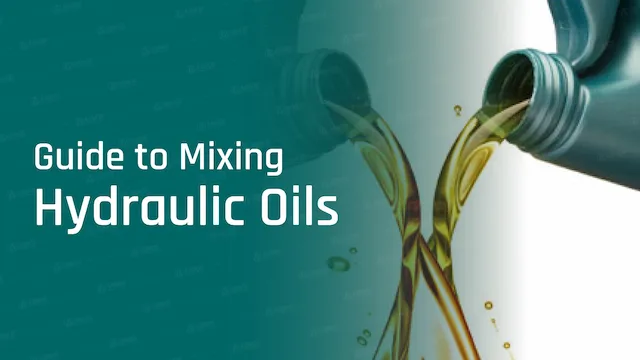- Armor Blog
- Products
- Guide to Safely Mixing Hydraulic Oils

Hydraulic Oil Basics
Hydraulic oils are the lifeblood of hydraulic systems, ensuring smooth and efficient operation. Understanding their properties and types is crucial for maintaining system performance and longevity.
Key Properties of Hydraulic Oils
Hydraulic oils possess several essential properties that define their performance:
- Viscosity and Viscosity Index: Viscosity refers to the oil’s resistance to flow. Hydraulic oils are graded based on their viscosity, typically using the ISO VG scale (e.g., ISO VG 32, 46, 68). A higher viscosity number indicates a thicker fluid. The viscosity index (VI) measures the oil’s ability to maintain its viscosity across temperature changes. Oils with a high VI are more stable and perform better under varying temperatures.
- Additives and Their Functions: Additives enhance the base oil’s properties or impart new ones. Common additives include anti-wear agents, rust inhibitors, and antioxidants. These additives help reduce wear, prevent corrosion, and extend the oil’s life by protecting it from oxidation
Risks of Mixing Different Hydraulic Oils
Mixing different hydraulic oils can lead to several issues that compromise the performance and longevity of hydraulic systems. It is crucial to understand these risks to avoid potential problems.
Chemical Incompatibility
Additive Clashes
- Different hydraulic oils contain unique additive packages designed to enhance specific properties. When mixed, these additives can react negatively with each other, leading to additive clash. This reaction can neutralize the beneficial effects of the additives, resulting in a loss of performance and protection
Resulting Chemical Reactions
- Formation of acids that can corrode system components.
- Development of gels or solids that clog filters and restrict oil flow.
- Precipitation of additives, leading to uneven distribution and localized wear.
Performance Degradation
Loss of Lubrication Efficiency:
- The primary function of hydraulic oil is to lubricate moving parts within the system. Mixing different oils can compromise this function, as the combined fluid may not provide the necessary lubrication properties. This can lead to increased friction, higher operating temperatures, and accelerated wear on components.
Increased Wear and Tear:
- Accelerated wear on seals and bearings.
- Increased risk of cavitation and air entrainment.
- Elevated operating temperatures, causing thermal stress on components
Avoiding the mixing of different hydraulic oils can prevent chemical incompatibilities and performance issues, ensuring the system operates smoothly and efficiently.
Assessing Compatibility of Hydraulic Oils
Before mixing hydraulic oils, it is essential to assess their compatibility to avoid potential risks. Detailed evaluation ensures that the oils can work together without causing adverse reactions or performance issues.
Conducting a Miscibility Test
A miscibility test is a practical way to determine if two hydraulic oils can be mixed without negative consequences. Follow these steps to perform the test and interpret the results:
Sample Collection
- Collect small, clean samples of both hydraulic oils.
- Ensure samples are free of contaminants and stored in clean containers.
Mixing Procedure
- In a clear container, mix equal parts of the two oils.
- Stir the mixture thoroughly to ensure complete blending.
Observation Period
- Allow the mixture to sit for 24 to 48 hours.
- Observe for any signs of separation, cloudiness, or sediment formation.
Interpreting Results
- Compatible Oils: If the mixture remains clear and homogeneous, the oils are likely compatible.
- Incompatible Oils: If the mixture shows separation, cloudiness, or sediment, the oils are not compatible and should not be mixed.
Manufacturer Recommendations
Consulting manufacturer recommendations is crucial for ensuring oil compatibility. Manufacturers provide specific guidelines based on extensive testing and experience.
Equipment Manuals
- Review the hydraulic system’s manual for recommended oil types.
- Follow the manufacturer’s guidelines on oil compatibility and mixing.
Supplier Advice
- Contact the hydraulic oil supplier for expert advice.
- Suppliers can conduct detailed miscibility tests and provide compatibility data.
OEM Specifications
- Adhere to the Original Equipment Manufacturer (OEM) specifications.
- OEM guidelines ensure optimal performance and warranty compliance.
Factors Influencing Compatibility
Several factors influence the compatibility of hydraulic oils, and understanding these can help in making informed decisions.
Base Oil Type
- Ensure the base oils are of similar types (e.g., both mineral or both synthetic).
Additive Packages
- Compare the additive packages to avoid clashes that can degrade performance.
Viscosity Grades:
- Mix oils with similar viscosity grades to maintain consistent performance.
Operating Conditions:
- Consider the operating conditions such as temperature and pressure.
- Oils must perform well together under the system’s specific conditions.
Best Practices for Mixing Hydraulic Oils
Mixing hydraulic oils requires careful planning and execution to maintain system performance and reliability. Following best practices helps mitigate risks associated with oil incompatibility and ensures smooth operation.
Gradual Transition Process
A gradual transition process is recommended when changing or mixing hydraulic oils to minimize disruption and potential incompatibility issues.
Draining Existing Oil
- Complete Drain: If feasible, completely drain the existing oil from the system to remove as much of the old fluid as possible.
- Flush System: Consider flushing the system with a compatible flushing fluid to clean out residual old oil and contaminants.
- Inspect and Clean Components: Clean or replace filters, check for any deposits or sludge, and ensure all components are in good condition before adding new oil.
Incremental Addition of New Oil
- Partial Fill: Initially, fill the system with a mix of old and new oil, typically starting with a small percentage of the new oil.
- Monitor Performance: Run the system and monitor its performance, looking for signs of incompatibility such as changes in viscosity, unusual noise, or temperature fluctuations.
- Gradual Increase: Gradually increase the proportion of the new oil in stages, allowing time between each stage to monitor the system’s response.
- Complete Transition: Once the system stabilizes with a higher percentage of the new oil, complete the transition by fully filling with the new oil.
Maintaining System Cleanliness
Cleanliness is paramount in hydraulic systems, especially when mixing oils. Contaminants can exacerbate incompatibility issues and lead to system failures.
Filtering New Oil
- Pre-filter New Oil: Before adding new oil to the system, filter it to remove any potential contaminants.
- Use Proper Filtration Equipment: Employ high-quality filtration equipment suitable for hydraulic oils to ensure thorough cleaning.
Regular System Checks and Maintenance
- Routine Inspections: Regularly inspect the hydraulic system for signs of contamination or wear.
- Replace Filters: Change filters according to the manufacturer’s recommendations or more frequently if contamination is detected.
- Monitor Oil Condition: Perform periodic oil analyses to check for contaminants, water content, and changes in viscosity.
Steps to Ensure Safe Mixing
Ensuring safe mixing of hydraulic oils involves several key steps that align with best practices and technical recommendations.
Compatibility Verification
- Miscibility Tests: Always conduct miscibility tests before mixing new oil with the existing one to confirm compatibility.
- Manufacturer Consultation: Consult with oil manufacturers or suppliers to verify compatibility and obtain technical support.
Controlled Environment
- Clean Work Area: Perform oil mixing and system maintenance in a clean, controlled environment to prevent dirt and contaminants from entering the system.
- Use Proper Tools: Utilize clean, appropriate tools and equipment for handling and transferring oils.
Document and Track Changes
- Keep Records: Maintain detailed records of oil changes, including types of oils used, quantities, and dates of changes.
- Monitor Performance: Track the system’s performance following oil changes to quickly identify and address any issues.
Addressing Potential Issues
Even with best practices, potential issues can arise when mixing hydraulic oils. Being prepared to address them promptly is crucial.
Identifying Incompatibility Signs
- Visual Inspection: Regularly inspect the oil for signs of separation, cloudiness, or sediment formation.
- Performance Monitoring: Watch for changes in system performance, such as unusual noise, increased temperature, or decreased efficiency.
Corrective Actions
- Partial Drain and Refill: If signs of incompatibility are detected, consider partially draining and refilling the system with compatible oil.
- Consult Experts: Seek advice from lubrication experts or the oil manufacturer to determine the best course of action.
Following these detailed best practices ensures a smooth and safe process when mixing hydraulic oils, maintaining system performance and avoiding potential risks associated with incompatibility.
Long-Term Maintenance and Monitoring
Proper long-term maintenance and monitoring are essential to ensure the longevity and optimal performance of hydraulic systems, especially when mixing oils. Implementing a robust maintenance routine helps in early detection of issues and prolongs the life of the hydraulic fluids and system components.
Regular Oil Analysis
Regular oil analysis is critical in maintaining hydraulic systems. It helps detect contaminants, monitor oil health, and plan maintenance activities.
Testing for Contaminants
- Particle Count: Regularly check for particulate contamination which can cause wear and damage.
- Water Content: Monitor water levels in the oil, as excessive water can lead to corrosion and reduce lubrication efficiency.
- Chemical Analysis: Perform chemical tests to identify any degradation products, such as acids or oxidation compounds.
Monitoring Viscosity Changes:
- Viscosity Index Check: Regularly measure the viscosity index to ensure the oil maintains its optimal thickness across temperature changes.
- Trend Analysis: Track viscosity over time to detect any significant changes that might indicate oil degradation or contamination.
Scheduled Oil Changes
Planning and adhering to a schedule for oil changes is crucial to maintain system performance and reliability.
Frequency Based on Usage
- High-Usage Systems: For systems with high operational hours or heavy loads, schedule more frequent oil changes.
- Moderate-Usage Systems: Adjust the frequency based on operational intensity and manufacturer’s recommendations.
Signs of Oil Degradation
- Color and Odor: Darkened oil or a burnt smell can indicate oxidation and the need for an oil change.
- Performance Decline: Noticeable drops in system performance, such as slower operation or increased noise, suggest it’s time to change the oil.
Preventive Maintenance Strategies
Implementing preventive maintenance strategies helps in avoiding unexpected breakdowns and extends the life of hydraulic systems.
Routine Inspections
- Visual Checks: Regularly inspect hydraulic components and oil condition visually.
- Leak Detection: Monitor for any signs of leaks, which can introduce contaminants into the system.
Component Maintenance
- Filter Replacement: Change filters regularly to maintain oil cleanliness and system efficiency.
- Seal and Hose Inspection: Check seals and hoses for wear and replace them as necessary to prevent leaks and contamination.
Continuous Improvement
Adopting a continuous improvement approach to hydraulic system maintenance ensures sustained efficiency and performance.
Feedback Loop
- Performance Tracking: Continuously track system performance and oil condition to identify areas for improvement.
- Adjust Maintenance Plans: Update maintenance schedules and practices based on performance data and oil analysis results.
Training and Education
- Staff Training: Ensure maintenance staff are well-trained in the latest hydraulic oil handling and system maintenance practices.
- Stay Updated: Keep abreast of advancements in hydraulic oil technology and maintenance techniques.
Ensuring the longevity and performance of your hydraulic systems requires diligent long-term maintenance and monitoring. By regularly analyzing oil, scheduling timely changes, and adopting preventive strategies, you can maximize the efficiency and reliability of your hydraulic systems.
For expert advice and premium hydraulic oil solutions, contact Armor Lubricants today. Our team is ready to help you maintain your systems with the best products and practices in the industry.
 Spear Lubricants
Spear Lubricants Armada lubricant
Armada lubricant Ace lubricants
Ace lubricants Perfect lubricants
Perfect lubricants Enzo lubricants
Enzo lubricants Lawrence lubricants
Lawrence lubricants